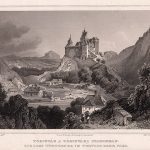
Tycho Brahe (1546-1601) has never set foot in the Round Tower given that the first plans to build the tower date back to the 1630s and Brahe died in 1601 – not even in Denmark but in exile in Prague, far from the Round Tower’s Copenhagen. Still, it is not completely nonsense to mention the renowned astronomer in the same breath as the Round Tower.
For, a direct line can be traced from Tycho Brahe’s observatories Uraniborg (Castle of Urania) and Stjerneborg (Castle of the Stars) on the small island of Hven in the Øresund Strait, which Brahe had to leave in 1597, to the observatory at the top of the Round Tower. Ironically enough, the Round Tower can be considered a manifestation in stone of the strict Lutheran orthodoxy, which played a crucial role in Tycho Brahe’s farewell to Denmark. However, the very same stones also form a circle with a diameter that is identical to the diameter of Stjerneborg whose basic unit of measurement, the so-called Tychonian foot, was allegedly also used in the construction of the Round Tower.
Nothing of this was coincidental. Just as the concept of apostolic succession is used within the church to designate the series of consecrated bishops that are believed to go back to the apostles by a continuous succession, it is also possible to talk about an astronomical succession when it comes to the connection between Tycho Brahe and the Round Tower. Source: Rundetaarn.dk




